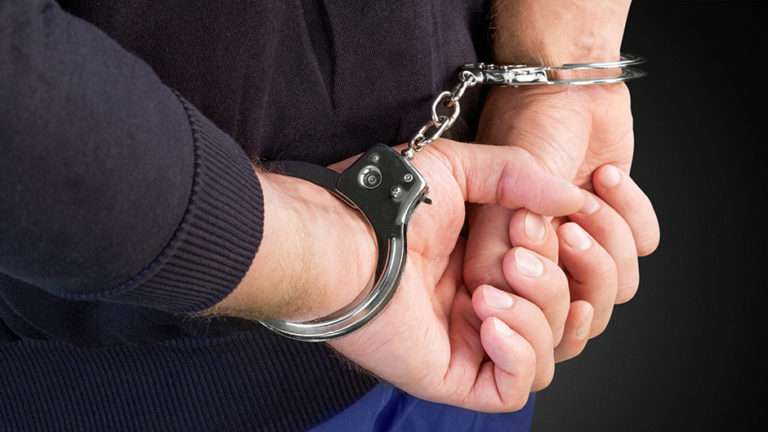Enhancing Situational Awareness: A Crucial Skill for Security Guards
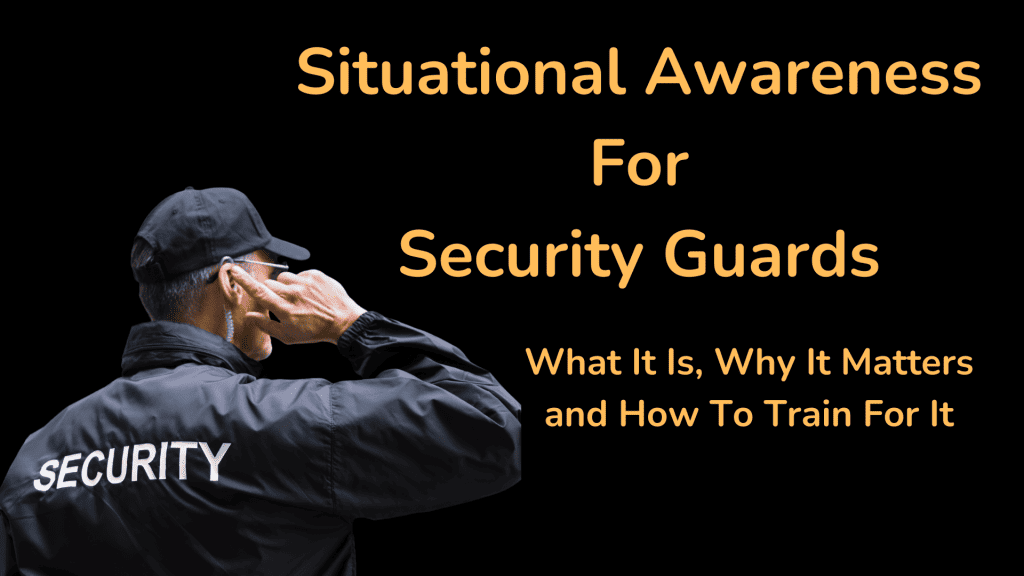
Introduction To Situational Awareness
Situational awareness is a crucial skill involving keen attentiveness to one's surroundings and the individuals within them, both in personal and professional settings.
It entails understanding the context and potential risks to enable proactive measures to ensure safety and security.
For security guards, situational awareness is paramount, enabling them to assess their environment, identify potential security threats, and swiftly take preventative actions.
Staying vigilant and perceptive allows them to respond effectively to security concerns, minimizing risks and maintaining a secure environment for all, including themselves and those they protect.
This heightened awareness empowers security guards to detect unusual activities, potential hazards, or suspicious individuals in real-time, aiding in swift and informed decision-making to prevent security breaches and minimize harm to people and property.
Good situational awareness offers numerous benefits, including enhanced safety for security personnel and the public.
It facilitates rapid and precise responses to security incidents, reducing the likelihood of escalation and damage, while also bolstering the effectiveness of security measures through a proactive approach to threat prevention and management.
Understanding Situational Awareness
Situational awareness is a fundamental concept in the realm of security work, encompassing a multidimensional understanding of the environment, events, and potential security threats.
Situational awareness involves these 3 stages – perception, comprehension, and projection of information to make informed decisions and take appropriate actions.
Each level plays a vital role in enhancing security measures and safeguarding individuals, assets, and communities.
Perception: Gathering Critical Information
Perception is the foundational level of situational awareness.
It involves gathering and interpreting information from the environment using sensory inputs such as sight, sound, and touch.
This includes recognizing patterns, identifying objects, and understanding the context of a situation.
In security work, perception is critical for detecting anomalies, unusual activities, or potential security threats.
Security personnel rely on keen observation skills to identify individuals acting suspiciously, unusual movements, or unauthorized access to restricted areas.
Without accurate perception, subsequent levels of situational awareness become ineffective.
Comprehension: Understanding the Implications
Comprehension involves understanding the significance and implications of the perceived information.
It requires processing the gathered data, recognizing patterns, and interpreting the situation in its entirety.
This level of awareness allows for a deeper understanding of the dynamics and potential risks associated with a given scenario.
In the context of security work, comprehension is crucial for assessing threats accurately.
Understanding the motives behind certain behaviours or recognizing potential security breaches is essential for making informed decisions regarding the appropriate response and intervention strategies.
Projection: Anticipating Future Developments
Projection is the highest level of situational awareness. It involves foreseeing the potential outcomes and future developments based on the information gathered and comprehended.
This proactive thinking enables security professionals to anticipate challenges, plan strategies, and implement preventive measures to mitigate risks.
In security operations, projection is vital for devising effective security protocols and strategies to thwart potential security threats.
It allows for the formulation of contingency plans, allocation of resources, and the development of response strategies that are proactive and preemptive.
Importance of Each Level in Security Work
All three levels of situational awareness are essential in security work. Perception allows security personnel to detect potential threats in real-time.
Comprehension enables a deeper understanding of the threat and the environment, aiding in appropriate decision-making.
Projection allows for proactive planning and preparedness, reducing the likelihood of security breaches and enhancing overall safety and security.
Security professionals must hone their skills at each level of situational awareness to effectively manage and respond to security challenges.
By being perceptive, understanding the context, and anticipating potential developments, security teams can create a safer environment for individuals and organizations alike.
Situational awareness is a cornerstone of effective security operations, contributing to a robust defence against evolving threats and risks.
Factors Affecting Situational Awareness
Situational awareness is significantly influenced by both external and internal factors.
Understanding how these factors impact situational awareness is essential for effectively navigating complex environments
External Factors
Environment
The environment in which an individual operates plays a substantial role in determining their level of situational awareness.
Factors such as terrain, weather conditions, and overall setting can affect visibility, audibility, and overall sensory perception.
Adverse environments, such as busy city streets or extreme weather conditions, can impair an individual's ability to accurately perceive and comprehend information.
Lighting
Lighting conditions significantly impact situational awareness.
Inadequate lighting or sudden changes in lighting levels can affect an individual's ability to perceive details and potential security threats.
Poorly lit areas may increase the risk of overlooking critical information, making it vital to adapt and employ appropriate tools or techniques to enhance visibility.
Crowd Size
The size and density of a crowd can also influence situational awareness. In crowded spaces, it becomes challenging to track individual actions and potential threats effectively.
Large crowds can cause sensory overload, making it difficult to focus on specific environmental elements.
Security personnel and individuals alike must adapt strategies to manage and maintain situational awareness in crowded settings.
Internal Factors
Stress
Stress is a significant internal factor that can significantly impair situational awareness.
High-stress situations can lead to cognitive tunnelling, where individuals become overly focused on specific aspects, overlooking other critical information.
Managing stress and employing stress-reduction techniques are essential to maintain optimal situational awareness during high-pressure situations.
Fatigue
Fatigue, whether physical or mental, can severely impact an individual's ability to maintain situational awareness.
Prolonged periods of activity without adequate rest can lead to decreased attention, slower reaction times, and diminished cognitive abilities.
Managing work schedules, taking breaks, and ensuring adequate rest are crucial in mitigating the effects of fatigue.
Distractions
Distractions divert attention away from the task at hand and can disrupt situational awareness.
In an era of technology, constant notifications, electronic devices, or unrelated conversations can divert attention from critical information.
Practising focus and mindfulness techniques can help individuals minimize distractions and maintain a high level of situational awareness.
Tools and Techniques for Enhancing Situational Awareness
Utilizing appropriate tools and employing effective techniques can significantly augment one's ability to perceive, comprehend, and project information accurately.
Here, we introduce essential tools and techniques that aid in bolstering situational awareness.
Tools for Enhancing Situational Awareness
Surveillance cameras
Security cameras provide real-time visual data from various vantage points.
They offer a comprehensive view of the surroundings, enhancing the perception level of situational awareness.
Modern systems include features such as remote monitoring and analytics, enabling real-time analysis of events and potential security threats.
Two-way radios
Radios facilitate immediate communication and coordination among team members.
They play a vital role in improving the comprehension level of situational awareness by ensuring that critical information is conveyed and received promptly.
Clear and effective communication is crucial for a timely and appropriate response to unfolding events.
Security software
Specialized security software such as integrated command and control systems, aids in gathering, analyzing, and managing information.
These systems can integrate data from various sources like sensors, surveillance cameras, and alarms, providing a centralized platform for monitoring and decision-making.
This tool significantly supports the projection level of situational awareness by enabling the anticipation of potential developments based on analyzed data.
Techniques for Enhancing Situational Awareness
The OODA loop (Observe, Orient, Decide, Act)
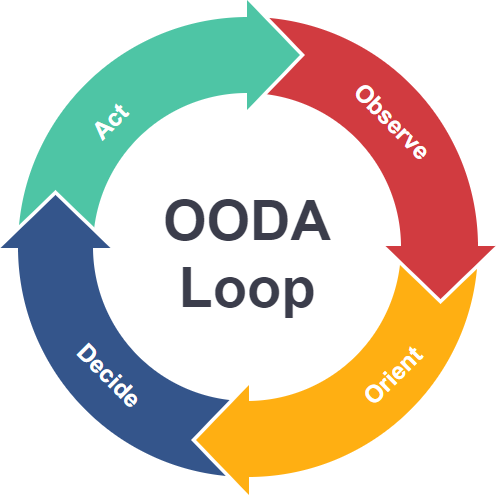
is a structured decision-making process with four critical stages.
Similar to other problem-solving methodologies, it is an interactive and iterative approach that involves a repetitive cycle, assessment of results, review of the initial decision, and progression to the subsequent step.
Though not always a linear progression, it is a dynamic and adaptable process consisting of four distinct phases:
Observe
The initiation of the OODA loop commences with the observation stage. In the context of security guard situational awareness, this phase necessitates the identification and understanding of potential problems or security threats within the environment.
This mirrors the crucial act of gathering relevant data in the security domain, encompassing insights into the current security status, potential threats, and the overall security landscape.
Recognizing the complexity of the security landscape is vital during this stage, as all available data represents a snapshot in time and must be promptly and astutely gathered to inform subsequent decision-making.
Orient
The orientation phase, paramount for security personnel, involves reflecting on the observations made and determining the appropriate course of action.
This phase demands a high level of situational awareness and understanding to make informed and conscious decisions.
In security, this step entails evaluating the ‘why' behind decisions, considering both conscious and instinctual aspects.
On an individual level, security personnel may create mental models or engage in mental rehearsal drills to structure information, aiding in shaping judgment and responses.
At an organizational level, situational models can be developed using machine learning (ML) tools to mitigate biases and predict potential outcomes.
Decide
Following orientation, the decision phase unfolds, suggesting actions or response plans while considering all potential outcomes.
This stage often involves discussions, meetings, or strategic planning sessions to outline a comprehensive roadmap for security operations.
Act
The final stage, action, involves executing the chosen plan and implementing necessary changes in response to the decision.
In security operations, this may encompass swift and precise responses, tests, or drills to validate the effectiveness of the selected actions before their official implementation, ensuring they align with the security objectives.
Cooper's Color Code System
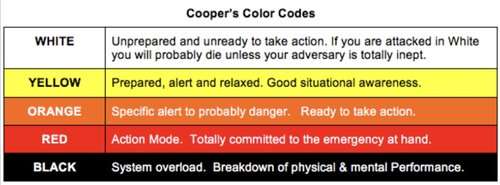
Jeff Cooper, a retired US Marine Corps member, devised a system outlining distinct levels of awareness characterized by colours. Cooper's Color Code encompasses five potential stages: white, yellow, orange, red, and black (although black is normally not included in the 4 stages of situational awareness).
Code Level White
Code Level White represents a state one should never occupy.
Being in level white signifies a complete lack of awareness regarding one's surroundings and a profound unpreparedness in the event of an attack.
This state is colloquially referred to as the “Facebook” level of awareness, inspired by individuals engrossed in their phones, neglecting their environment.
Code Level Yellow
This is the ideal state for most situations. In Level Yellow, one remains vigilant of their surroundings while maintaining a relaxed yet prepared demeanour.
Code Level Orange
Code Level Orange indicates an escalated awareness, acknowledging a potential threat and preparing to respond accordingly.
Code Level Red
Level Red signifies active engagement in an emergency, where focus is directed towards managing the crisis.
However, the risk lies in this heightened concentration, potentially causing individuals to overlook secondary security threats like associates of the initial attacker.
Color Code Black
At this level panic sets in, resulting in a state of paralysis and mental shutdown.
This state is the most detrimental, rendering a person incapable of responding effectively to the situation.
Practical Tips for Security Guards
Enhancing situational awareness is crucial for security guards to effectively carry out their responsibilities and maintain a safe environment.
Here are some practical tips to achieve this:
Regularly Scan the Environment
Maintaining a consistent and systematic approach to scanning one's surroundings is fundamental for security guards.
This includes thorough monitoring of perimeters, entrances, and high-traffic areas. Implementing a structured pattern, like the “360-degree scan,” enhances the ability to achieve comprehensive coverage and effectively detect potential security threats.
By adhering to this vigilant scanning regimen, security personnel can heighten the overall security posture and promptly respond to any signs of suspicious activity or potential security risks within their environment.
Stay Alert and Focused
Security guards must uphold a heightened state of alertness consistently during their shifts, ensuring they remain focused and undistracted.
Being attuned to any unusual activities or behaviours in the environment is paramount for the early detection of potential security threats.
To combat fatigue and maintain this vigilance, taking short breaks is essential to rejuvenate and refocus the mind.
These breaks play a pivotal role in sustaining optimal levels of attention and overall performance.
Practice Visualization and Mental Rehearsal
Engaging in mental rehearsal of potential scenarios and appropriate responses is a vital practice for security guards to enhance their preparedness for critical situations.
By mentally visualizing successful outcomes and practising decision-making in stressful conditions, security personnel can sharpen their reaction times and overall effectiveness.
This proactive approach helps in honing their ability to swiftly and accurately respond to various challenging situations.
Communicate Effectively with Team Members
Creating clear and efficient communication channels within the security team is of paramount importance.
These channels facilitate the seamless sharing of vital information and coordination of responses among team members.
Utilizing effective communication devices like two-way radios ensures that team members stay connected and updated on ongoing situations, potential security threats, or any changes in the environment in real time.
This enhances the team's ability to respond promptly and cohesively to emerging security challenges.
Training and Practice
Security guards must undergo regular training to sharpen their situational awareness skills.
Such training keeps them up to date with the latest security protocols, technologies, and methodologies.
Additionally, practice allows guards to adapt to evolving security threats, making them more adept at interpreting their surroundings and potential risks.
Real-Life Examples
While specific details of security-related incidents may not always be publicly disclosed or widely available due to security concerns, there are real-life situations where situational awareness has played a crucial role in preventing or mitigating security threats.
Here are a couple of examples:
2014 Attack on Canadian Parliament Hill

In October 2014, a gunman attacked Ottawa's National War Memorial and the Parliament of Canada. Security personnel and law enforcement demonstrated situational awareness and rapid response, neutralizing the threat and preventing further harm.
Their quick and coordinated actions safeguarded the parliamentarians and visitors present during the incident.
2019 London Bridge Attack
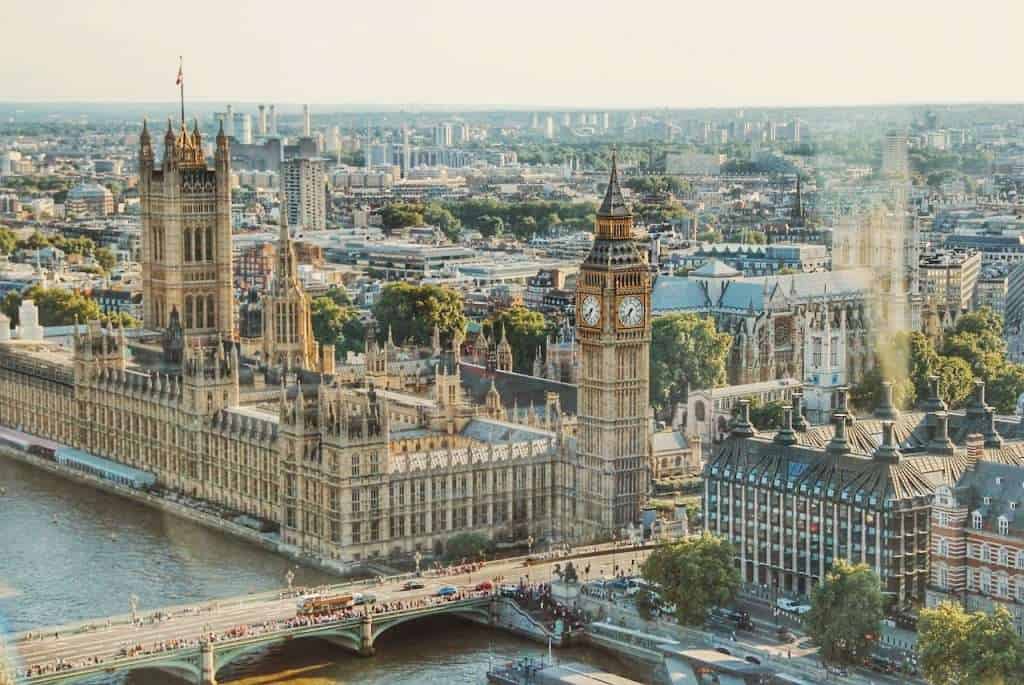
In the 2019 London Bridge attack, bystanders and law enforcement demonstrated exceptional situational awareness.
When a terrorist began attacking people with a knife, civilians quickly assessed the threat and acted decisively to subdue the attacker, using improvised weapons.
Their situational awareness and swift response likely prevented further casualties.
Conclusion
Situational awareness is a critical skill for security guards, involving keen perception, comprehension, and projection of information in both personal and professional settings.
It empowers security personnel to swiftly detect potential threats, make informed decisions, and take proactive measures to ensure safety and security.
Understanding the levels of situational awareness – perception, comprehension, and projection – is fundamental in fortifying security measures.
These levels aid in identifying anomalies, comprehending the context, and foreseeing potential developments, ultimately allowing for effective threat prevention and management.
External and internal factors significantly influence situational awareness. Adverse environments, stress, fatigue, and distractions can impair it.
Employing tools like surveillance cameras, two-way radios, and effective techniques such as the OODA loop and Cooper's Color Code System can significantly enhance situational awareness.
Share the Knowledge, Save Lives
Share this blog with others to spread awareness about the criticality of situational awareness, especially within security roles.
Your share could make a difference in fortifying safety measures and enhancing overall security.
Last Updated on Sep 23, 2024





